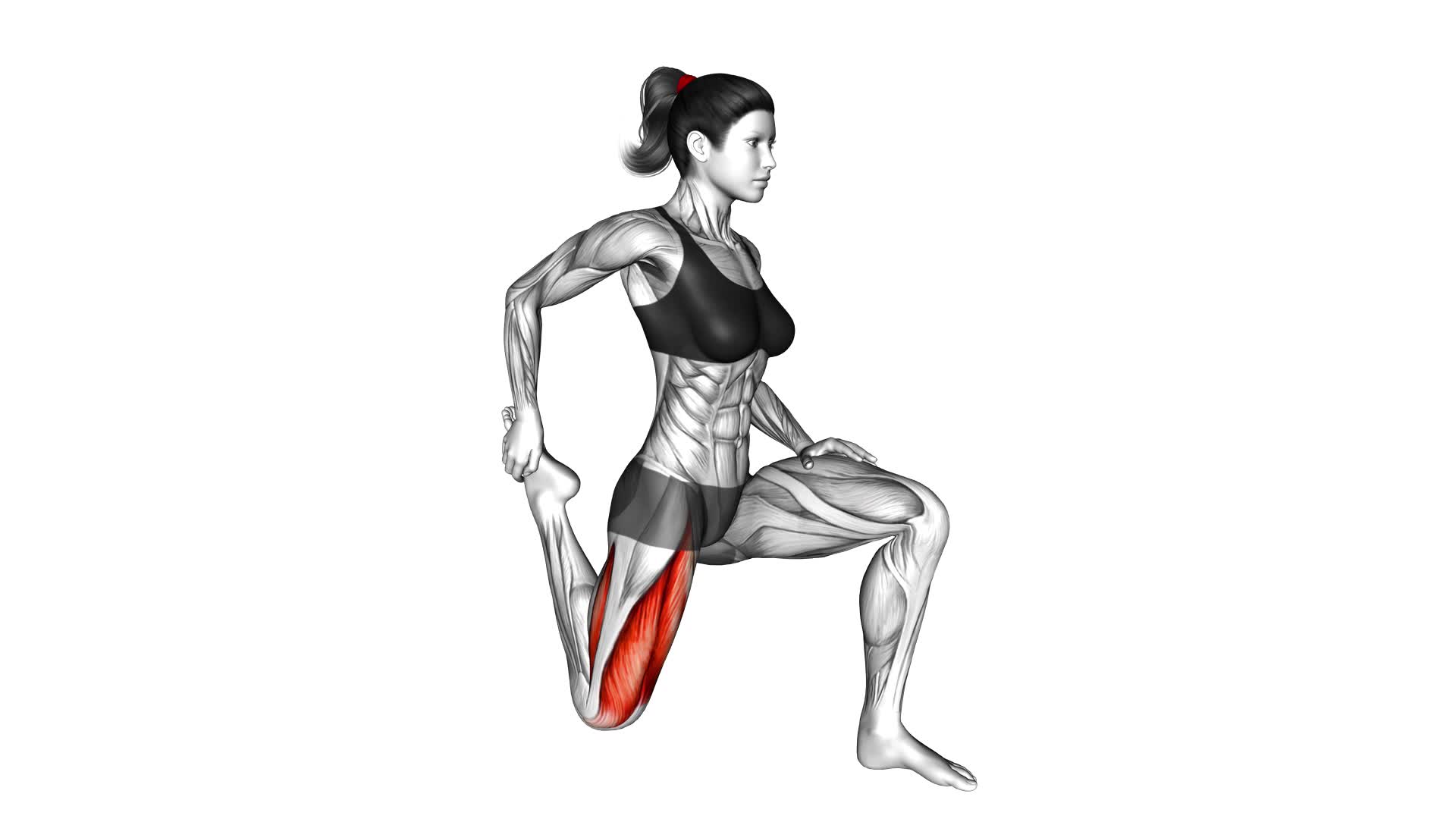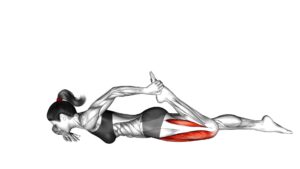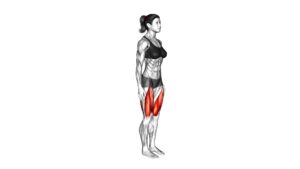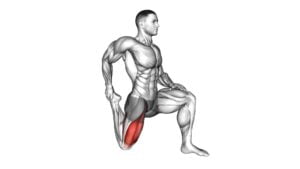Quadriceps Stretch (female) – Video Exercise Guide & Tips

Are you looking for a quick and effective way to stretch your quadriceps? Look no further!
Watch This Exercise Video
In this video exercise guide, we'll show you the proper technique for the quadriceps stretch, along with variations and modifications to suit your needs.
Plus, we'll share tips to help you get the most out of this stretch and avoid common mistakes.
Get ready to improve your flexibility and prevent muscle tightness with the quadriceps stretch.
Let's get started!
Key Takeaways
- The quadriceps stretch is an effective exercise for injury prevention and flexibility improvement.
- It reduces the risk of muscle strains and tears in the quadriceps.
- The stretch improves flexibility in the hip and knee joints.
- It enhances athletic performance and overall functional movement.
Benefits of the Quadriceps Stretch
To maximize the results of your quadriceps stretch, understanding its benefits is essential. The quadriceps stretch is an effective exercise for injury prevention and flexibility improvement. By regularly performing this stretch, you can reduce the risk of muscle strains and tears in the quadriceps, which are the large muscles in the front of your thighs.
This is especially important if you participate in activities that require explosive movements or quick changes in direction, such as running or playing sports. Additionally, the quadriceps stretch helps improve flexibility in the hip and knee joints, allowing for a greater range of motion. This increased flexibility can enhance your athletic performance and overall functional movement.
By properly stretching the quadriceps, you can also alleviate tightness and discomfort in the front of your thighs, which can be caused by prolonged sitting or activities that involve repetitive leg movements. So, by incorporating the quadriceps stretch into your exercise routine, you can reap the benefits of injury prevention and improved flexibility.
Now, let's move on to the next section and learn about the proper technique for the quadriceps stretch.
Proper Technique for the Quadriceps Stretch
To properly perform the quadriceps stretch, follow these steps.
Begin by standing upright with your feet hip-width apart. Maintain good posture throughout the exercise, engaging your core muscles.
Take a step forward with your right foot, keeping your knee slightly bent. Lift your left foot off the ground and bring it towards your glutes, grabbing your left ankle or foot with your left hand. Keep your knees close together and your thighs parallel as you pull your heel towards your glutes. Hold this position for 20-30 seconds, feeling a stretch in the front of your thigh. Avoid arching your back or leaning forward. Repeat the stretch on the other leg.
Common mistakes to avoid include pulling on your foot too forcefully, which can strain the knee or ankle. Additionally, avoid leaning forward or arching your back, as this can reduce the effectiveness of the stretch.
Now that you know the proper technique for the quadriceps stretch, let's move on to variations and modifications that can help you customize the exercise to your needs.
Variations and Modifications for the Quadriceps Stretch
Now let's explore different ways you can modify and vary the quadriceps stretch to suit your individual needs and preferences. Here are some variations and modifications for the quadriceps stretch:
- Standing Quadriceps Stretch: Instead of lying on your side, stand upright and grab your foot behind you, pulling it towards your glutes. This variation allows you to stretch your quadriceps while maintaining balance and stability.
- Chair Assisted Quadriceps Stretch: Sit on the edge of a chair and extend one leg in front of you. Hold onto the chair for support and gently lean back to stretch your quadriceps. This modification is great for individuals who've difficulty balancing or need extra stability.
- Wall Quadriceps Stretch: Stand facing a wall and place one hand on it for support. Bend one knee and grab your foot with the opposite hand, pulling it towards your glutes. This variation adds a stability element and allows you to control the intensity of the stretch.
By incorporating these quadriceps stretch variations and modifications, you can customize your stretching routine to target different angles and intensities.
Now, let's move on to the next section to learn some tips for getting the most out of the quadriceps stretch.
Tips for Getting the Most Out of the Quadriceps Stretch
To maximize the benefits of the quadriceps stretch, follow these tips to ensure proper form and effectiveness.
First, warm up your muscles with a few minutes of light cardio exercises, such as jogging or jumping jacks. This will increase blood flow and prepare your muscles for stretching.
Next, find a comfortable position for the stretch. Stand near a wall or a sturdy chair for support, and make sure you have enough space to extend your leg fully. Keep your back straight and engage your core muscles to maintain stability.
When performing the stretch, focus on the muscle group you're targeting. Feel the stretch in your quadriceps as you extend your leg behind you. Hold the stretch for about 30 seconds, making sure not to bounce or jerk your leg.
Finally, breathe deeply and relax into the stretch. Remember to stretch both legs evenly to maintain balance and flexibility.
Common Mistakes to Avoid During the Quadriceps Stretch
What are some common mistakes you should avoid while performing the quadriceps stretch? To ensure you're getting the most out of this exercise and avoiding injury, it's important to understand proper technique and be aware of common mistakes. Here are some things to watch out for:
- Rushing through the stretch: One common mistake is rushing through the quadriceps stretch. This can lead to ineffective stretching and potential strain on your muscles. Take your time and hold the stretch for the recommended duration to fully benefit from it.
- Leaning too far forward: Another mistake is leaning too far forward while performing the stretch. This can put unnecessary pressure on your knee joint and compromise the effectiveness of the exercise. Remember to keep your upper body upright and avoid leaning forward.
- Not engaging the core: Neglecting to engage your core during the quadriceps stretch is a common error. Your core muscles play a crucial role in maintaining balance and stability. By engaging your core, you can ensure proper alignment and maximize the benefits of the stretch.
Frequently Asked Questions
How Long Should I Hold the Quadriceps Stretch?
To maximize the benefits of the quadriceps stretch, it's important to hold the stretch for an appropriate duration. The duration of the quadriceps stretch depends on your fitness level and flexibility. Generally, it's recommended to hold the stretch for 15 to 30 seconds.
This allows enough time for the muscles to relax and lengthen, improving your flexibility and reducing the risk of injury. Remember to breathe deeply and relax during the stretch for optimal results.
Can I Do the Quadriceps Stretch if I Have Knee Pain?
Yes, you can still do the quadriceps stretch if you have knee pain. However, it's important to be cautious and make modifications to ensure you don't aggravate your pain.
One option is to combine the quadriceps stretch with knee-friendly exercises, such as seated leg lifts.
Additionally, you can try using props, like a towel or foam roller, to provide support and reduce strain on your knees during the stretch.
Remember to listen to your body and stop if you feel any discomfort.
Is It Better to Do the Quadriceps Stretch Before or After a Workout?
It's important to know whether it's better to do the quadriceps stretch before or after a workout. Doing the stretch before your workout can help warm up your muscles and increase flexibility, reducing the risk of injury.
On the other hand, doing the stretch after your workout can help cool down your muscles and improve recovery.
Can I Do the Quadriceps Stretch if I Have a Knee Replacement?
If you have had a knee replacement, it's important to consult with your doctor or physical therapist before attempting the quadriceps stretch. They can provide guidance on whether it's safe for you and if any modifications are needed.
The quadriceps stretch can be beneficial for improving flexibility and range of motion, but it's crucial to prioritize your post-surgery recovery and follow professional advice to ensure a successful rehabilitation process.
What Other Stretches Can I Combine With the Quadriceps Stretch for a Full Leg Workout?
To achieve a full leg workout, you can combine the quadriceps stretch with other stretches like calf stretches and hamstring stretches. These stretches target different muscles in your legs, helping to improve flexibility and prevent muscle imbalances.
Calf stretches involve stretching the muscles in your calf, while hamstring stretches focus on the muscles at the back of your thigh. Incorporating these stretches into your routine will give you a well-rounded leg workout.
Conclusion
In conclusion, the quadriceps stretch is a highly beneficial exercise for improving flexibility and preventing muscle imbalances. By following the proper technique and using variations or modifications as needed, you can effectively stretch your quadriceps muscles.
Remember to listen to your body, avoid common mistakes, and make the most out of this stretch to maximize its benefits.
Incorporating the quadriceps stretch into your regular workout routine can help enhance your overall fitness and performance.

Author
Years ago, the spark of my life’s passion ignited in my mind the moment I stepped into the local gym for the first time. The inaugural bead of perspiration, the initial endeavor, the very first surge of endorphins, and a sense of pride that washed over me post-workout marked the beginning of my deep-seated interest in strength sports, fitness, and sports nutrition. This very curiosity blossomed rapidly into a profound fascination, propelling me to earn a Master’s degree in Physical Education from the Academy of Physical Education in Krakow, followed by a Sports Manager diploma from the Jagiellonian University. My journey of growth led me to gain more specialized qualifications, such as being a certified personal trainer with a focus on sports dietetics, a lifeguard, and an instructor for wellness and corrective gymnastics. Theoretical knowledge paired seamlessly with practical experience, reinforcing my belief that the transformation of individuals under my guidance was also a reflection of my personal growth. This belief holds true even today. Each day, I strive to push the boundaries and explore new realms. These realms gently elevate me to greater heights. The unique combination of passion for my field and the continuous quest for growth fuels my drive to break new ground.







